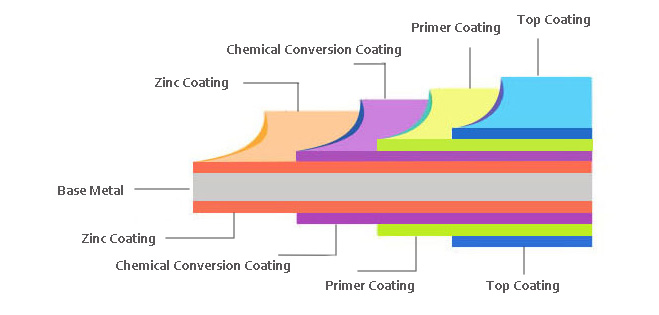Color coated coil is composed of top coat, primer, coating, substrate and back paint.
Finish paint: shield the sun, prevent ultraviolet damage to the coating; When the finish reaches the specified thickness, it can form a dense shielding film, reducing the permeability of water and oxygen.
Primer: it is beneficial to strengthen the adhesion of the substrate, so that paint desorption is not easy to occur after the film is permeated with water, and it will also improve the corrosion resistance, because the primer contains corrosion inhibitor pigments, such as chromate pigments, so that the anode is passivated and the corrosion resistance is improved.
Coating: generally galvanized or aluminum zinc plating, this part of the service life of the product has the greatest impact, the thicker the coating is, the better the corrosion resistance.
Substrate: generally for cold rolled plate, different strength determines the mechanical properties of color coated plate can bear.
Back paint: the function is to prevent corrosion of steel plate from the inside, generally two layers of structure (2/1M or 2/2, primer + back paint), if the back needs to be bonded, it is recommended to use a single layer structure (2/1).
Color coated steel coil corrosion process:
Dulling coating, coating color coating, powder coating, cracking foaming coating, white/red — – — – — in the cutting line peeling rust – cut – coating area off — – — – — large area of the rust, local red rust – plate – corrosion perforation plate failure.
The failure process of color-coated steel plate is shown in the figure above. Coating failure, coating failure and perforation of steel plate are the key corrosion processes. Therefore, increasing the thickness of coating and using weathering and corrosion resistant coating are the most effective means to prevent corrosion failure of color coated steel plate.
Post time: Jun-10-2022
